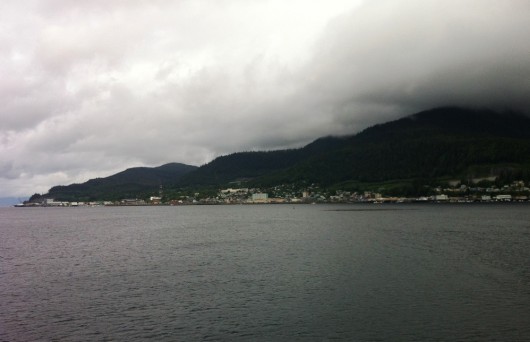It’s still preliminary, but the City of Ketchikan is looking into filtration as an option for treating its water. Filtration would solve some of the city’s recent water woes, but it wouldn’t necessarily mean the end to chemical disinfection.
Ketchikan’s city government has tried for many years – and still is trying – to avoid building an expensive filtration plant. But it’s getting harder, as federal regulations related to disinfection byproducts get more stringent.
In addition, the city’s raw source water – Ketchikan Lakes – has been testing above allowed levels for the bacteria coliform.
Coliform is destroyed by the city’s treatment process, but the Environmental Protection Agency still requires untreated water to test below a certain level in unfiltered systems. If the city can’t figure out how to get the levels down, it’s going to have to filter.
So, the City Council recently asked for a report on options for filtration systems. Water Division Manager John Kleinegger’s response has two options. One is a conventional filtration plant, which could cost an estimated $35 million. Then there is a relatively new technology – membrane microfiltration.
“Basically, from my standpoint, it’s a possibility and we would certainly want to study it,” Kleinegger said in a Wednesday interview.
Membrane microfiltration is not cheap, by any means. But, the basic equipment for such a system is not too bad – especially compared to the conventional filtration plant. Hard numbers aren’t yet available, but here’s rough idea:
“The cost just for the microfiltration equipment themselves is about a dollar per gallon, and we need to have the capability of providing at our peak season, about nine and a half million gallons per day,” Kleinegger said.
So, $9.5 million.
That doesn’t include the yet-unknown cost of a building to house the equipment, pumps to run it, or the potential cost related to all the stuff that the membrane takes out of the water.
Testing will be needed to figure that out.
“We would probably take raw water and run it through a membrane filtration cell, and see how much particulate matter we would create, and from that you could make an estimate that the particulate matter that you capture – could it be returned it to the sewer, or will we have to dispose of it in some other manner, which adds greatly to the cost,” Kleinegger said.
Incineration would be the likely manner of disposal, if the filtered matter can’t be added to the sewer system.
Another bonus to membrane microfiltration rather than conventional filtration is that it would take up less space – it could be built on property the city already owns, right next to the new chloramination water treatment facility.
Speaking of chloramination – which has been controversial – Kleinegger said that filtration won’t necessarily mean an end to that kind of disinfection.
“The water that we’re passing through the membrane filtration – is it going to remove the dissolved organics? The answer is probably not,” he said. “We have to use chlorine for the elimination of viruses. And if we have dissolved organics, and you add chlorine, well you’re going to make haloacetic acids.”
The city’s water has tested above allowed levels for EPA-regulated byproducts such as haloacetic acids for many years, which is why the city opted to build its new chloramine disinfection system. Chloramine is a mixture of chlorine and ammonia. That kind of system requires less chlorine, and chlorine is what creates the regulated byproducts when it comes in contact with organic material.
Kleinegger said there are additional chemicals involved in filtration systems. Coagulants, for example.
“They’re charged particles. You create them with a mixture of polymers and alum, and then that way you’re able to capture, hopefully, the things like dissolved organics,” he said.
And while some people are worried about the health effects of chloramine in the water, Kleinegger said the chemicals related to filtration have their own set of concerns.
“Alum contains aluminum. Aluminum is a suspect chemical in Alzheimer’s,” he said.
Kleinegger’s report is part of the Ketchikan City Council’s meeting packet for Thursday night. Also on the agenda is a motion to hire consultants CH2M-Hill to design an adjustment to the city’s new water disinfection system. While the city’s new system has reduced byproducts to below allowed levels, they are still too close to the threshold. And warmer weather means those levels likely will rise.
The proposed adjustment would add less chlorine at the start of the system. After the water has gone through the ultra-violet disinfection, the rest of the chlorine would be added, along with ammonia.






